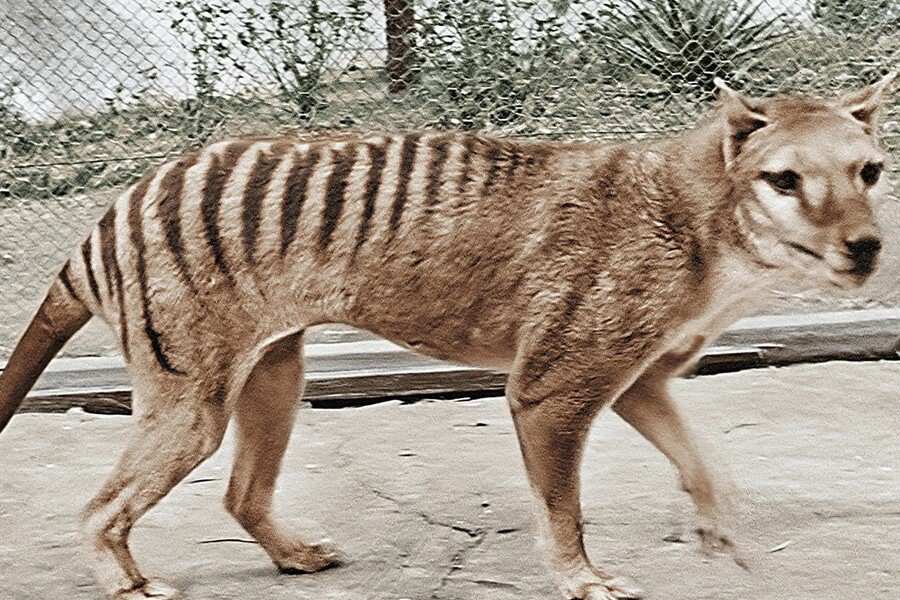Decades after the last known Tasmanian tiger, or thylacine, died in captivity, scientists are closer than ever to bringing this extinct species back to life. In a recent breakthrough, Colossal Biosciences, a Dallas-based company, announced that their reconstructed genome for the thylacine is 99.9% complete, marking significant progress in their de-extinction efforts. This milestone, coupled with cutting-edge gene-editing technology, offers a glimmer of hope for the return of the iconic carnivore.
Reconstructing a Lost Species
The thylacine, a marsupial native to Tasmania, was declared extinct in 1936 after excessive hunting pushed the population to the brink. Once roaming freely across Australia and Tasmania, the species faced mass culling, as local governments encouraged hunting to protect livestock from these carnivores. The last known thylacine died at the Beaumaris Zoo in Hobart, Tasmania.
Fast forward to today, scientists have taken a step closer to reversing that loss. In a press release, Colossal Biosciences shared that their team had managed to isolate and sequence long RNA molecules from a 110-year-old preserved thylacine head, which was kept in ethanol. “The thylacine samples used for our new reference genome are among the best-preserved ancient specimens my team has worked with,” said Beth Shapiro, Colossal’s chief science officer. “It’s rare to have a sample that allows you to push the envelope in ancient DNA methods to such an extent.”
Decoding Ancient DNA and RNA
The ability to extract RNA from preserved specimens is a game-changer. While DNA helps in recreating the genetic blueprint of a species, RNA offers insights into gene expression — essentially, how the species looked, behaved, and functioned. Researchers have been able to study RNA from critical tissue areas like the tongue, brain, and eyes. This will allow them to deduce what a thylacine could taste, how it processed smells, and even its brain functionality.
Andrew Park, a member of Colossal’s Scientific Advisory Board and a researcher at the University of Melbourne’s TIGRR Lab, expressed optimism, stating, “We’re getting closer every day to being able to place the thylacine back into the ecosystem.”
Editing Genes with a Little Help From the Dunnart
Colossal’s approach to de-extinction relies on gene-editing techniques. Their goal is to insert edited thylacine genes into the DNA of the fat-tailed dunnart, a small marsupial and the closest living relative of the Tasmanian tiger. By making over 300 genetic “edits,” scientists aim to transform dunnart cells into thylacine cells.
“We’re pushing the frontier of de-extinction technologies,” said Andrew Pask, a collaborator from the University of Melbourne. “From innovative ways of finding the regions of the genome driving evolution to novel methods to determine gene function, we are in the best place ever to rebuild this species using the most thorough genome resources.”
Challenges and Criticism
The concept of de-extinction is not without its critics. While technological strides are being made, ethical concerns continue to cast a shadow on these efforts. Some conservationists argue that millions of dollars invested in projects like this would be better spent preserving habitats of species currently at risk of extinction. Others raise concerns about the ecological impact of reintroducing a long-extinct predator into an ecosystem that has changed drastically since the thylacine’s time.
Professor Jeremy Austin, from the Australian Centre for Ancient DNA, has voiced skepticism, calling de-extinction “a fairy tale science.” He, and others, point out that even if scientists succeed in creating a thylacine, its reintroduction might not be practical, as the degraded environments it once thrived in may no longer support its survival.
A Step Towards the Future
Despite these concerns, Colossal Biosciences is undeterred. This isn’t their first venture into de-extinction; the company has also announced projects to bring back the woolly mammoth and the dodo. They believe these efforts could help build a toolkit for conservation, enabling scientists to preserve genetic diversity and perhaps save other species currently on the brink of extinction.
For now, the dream of seeing a Tasmanian tiger prowling through the wilderness remains just that — a dream. However, with each genetic edit and breakthrough, scientists are getting closer to making it a reality. Only time will tell whether these efforts will succeed and what this means for the future of conservation science.
